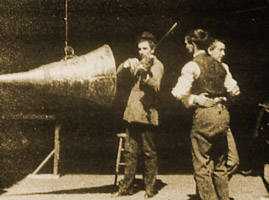|
John Malcolm Stahl
John Malcolm Stahl (January 21, 1886 – January 12, 1950) was a Russian-born American film director and producer. He is best known for his films such as ''Leave Her to Heaven'' (1945), '' Imitation of Life'' (1934), ''The Keys of the Kingdom'' (1945), and '' Back Street'' (1932). Life and work He was born Jacob Morris Strelitsky in Baku (Azerbaijan) to a Russian Jewish family. When he was a child, his family left the Russian Empire and moved to the United States, settling in New York City. At a young age he took the name John Malcolm Stahl and began working, first as a theatre actor and then in the city's growing motion picture industry. He directed his first silent film short in 1913. In 1919 he signed on with Louis B. Mayer Pictures in Hollywood. In 1924 he was part of the Mayer team that founded MGM Studios. In 1927, Stahl was one of the thirty-six founding members of the Academy of Motion Picture Arts and Sciences. When the industry transitioned to talkies and feat ... [...More Info...] [...Related Items...] OR: [Wikipedia] [Google] [Baidu] |
Baku
Baku (, ; ) is the Capital city, capital and List of cities in Azerbaijan, largest city of Azerbaijan, as well as the largest city on the Caspian Sea and in the Caucasus region. Baku is below sea level, which makes it the List of capital cities by elevation, lowest lying national capital in the world and also the largest city in the world below sea level. Baku lies on the southern shore of the Absheron Peninsula, on the Bay of Baku. Baku's urban population was estimated at two million people as of 2009. Baku is the primate city of Azerbaijan—it is the sole metropolis in the country, and about 25% of all inhabitants of the country live in Baku's metropolitan area. Baku is divided into #Administrative divisions, twelve administrative raions and 48 townships. Among these are the townships on the islands of the Baku Archipelago, as well as the industrial settlement of Neft Daşları built on oil rigs away from Baku city in the Caspian Sea. The Old City (Baku), Old City, conta ... [...More Info...] [...Related Items...] OR: [Wikipedia] [Google] [Baidu] |
Russian Empire
The Russian Empire was an empire that spanned most of northern Eurasia from its establishment in November 1721 until the proclamation of the Russian Republic in September 1917. At its height in the late 19th century, it covered about , roughly one-sixth of the world's landmass, making it the list of largest empires, third-largest empire in history, behind only the British Empire, British and Mongol Empire, Mongol empires. It also Russian colonization of North America, colonized Alaska between 1799 and 1867. The empire's 1897 census, the only one it conducted, found a population of 125.6 million with considerable ethnic, linguistic, religious, and socioeconomic diversity. From the 10th to 17th centuries, the Russians had been ruled by a noble class known as the boyars, above whom was the tsar, an absolute monarch. The groundwork of the Russian Empire was laid by Ivan III (), who greatly expanded his domain, established a centralized Russian national state, and secured inde ... [...More Info...] [...Related Items...] OR: [Wikipedia] [Google] [Baidu] |
Studio Executive
A studio executive is an employee of a film studio or a corporation doing business in the entertainment industry. A studio executive may be a chief executive officer (CEO), a chief financial officer (CFO), or a chief operating officer (COO), or be employed to serve in a variety of vice presidential capacities, such as senior vice president of corporate relations. A studio executive may oversee production or may serve in a role identical to a corporation that is not involved in the entertainment industry. ''Studio executive'' is commonly used to describe someone who takes responsibility for all interests, financial or otherwise, between the film studio and the production company A production company, production house or production studio is a studio that creates works in the fields of performing arts, new media art, film, television show, television, radio, comics, interactive arts, video games, websites, music, and video ... of a film. References Sources * Filmmaking occ ... [...More Info...] [...Related Items...] OR: [Wikipedia] [Google] [Baidu] |
Feature Film
A feature film or feature-length film (often abbreviated to feature), also called a theatrical film, is a film (Film, motion picture, "movie" or simply “picture”) with a running time long enough to be considered the principal or sole presentation in a commercial entertainment theatrical program. The term ''feature film'' originally referred to the main, full-length film in a cinema program that included a short film and often a newsreel. Matinee programs, especially in the United States and Canada, in general, also included cartoons, at least one weekly serial film, serial and, typically, a second feature-length film on weekends. The first narrative feature film was the 70-minute ''The Story of the Kelly Gang'' (1906). Other early feature films include ''Les Misérables (1909 film), Les Misérables'' (1909), ''L'Inferno'', ''Defence of Sevastopol, The Adventures of Pinocchio (1911 film), The Adventures of Pinocchio'' (1911), ''Oliver Twist (1912 American film), Oliver Twist'' ... [...More Info...] [...Related Items...] OR: [Wikipedia] [Google] [Baidu] |
Sound Film
A sound film is a Film, motion picture with synchronization, synchronized sound, or sound technologically coupled to image, as opposed to a silent film. The first known public exhibition of projected sound films took place in Paris in 1900, but decades passed before sound motion pictures became commercially practical. Reliable synchronization was difficult to achieve with the early sound-on-disc systems, and amplification and recording quality were also inadequate. Innovations in sound-on-film led to the first commercial screening of Short film, short motion pictures using the technology, which took place in 1923. Before sound-on-film technology became viable, soundtracks for films were commonly played live with organs or pianos. The primary steps in the commercialization of sound cinema were taken in the mid-to-late 1920s. At first, the sound films which included synchronized dialogue, known as "talking pictures", or "talkies", were exclusively shorts. The earliest feature fil ... [...More Info...] [...Related Items...] OR: [Wikipedia] [Google] [Baidu] |
Academy Of Motion Picture Arts And Sciences
The Academy of Motion Picture Arts and Sciences (AMPAS, often pronounced ; also known as simply the Academy or the Motion Picture Academy) is a professional honorary organization in Beverly Hills, California, U.S., with the stated goal of advancing the arts and sciences of motion pictures. The Academy's corporate management and general policies are overseen by a board of governors, which includes representatives from each of the craft branches. As of April 2020, the organization was estimated to consist of around 9,921 motion picture professionals. The Academy is an international organization and membership is open to qualified filmmakers around the world. The Academy is known around the world for its annual Academy Awards, both officially and popularly known as "The Oscars". In addition, the Academy holds the Governors Awards annually for lifetime achievement in film; presents Academy Scientific and Technical Award, Scientific and Technical Awards annually; gives Student Aca ... [...More Info...] [...Related Items...] OR: [Wikipedia] [Google] [Baidu] |
Metro-Goldwyn-Mayer
Metro-Goldwyn-Mayer Studios Inc. (also known as Metro-Goldwyn-Mayer Pictures, commonly shortened to MGM or MGM Studios) is an American Film production, film and television production and film distribution, distribution company headquartered in Beverly Hills, California. Metro-Goldwyn-Mayer was founded on April 17, 1924, and has been owned by the Amazon MGM Studios subsidiary of Amazon (company), Amazon since 2022. MGM was formed by Marcus Loew by combining Metro Pictures, Goldwyn Pictures and Louis B. Mayer Pictures into one company. It hired a number of well-known actors as contract players—its slogan was "more stars than there are in heaven"—and soon became Hollywood's most prestigious filmmaking company, producing popular musical films and winning many Academy Awards. MGM also owned film studios, movie lots, movie theaters and technical production facilities. Its most prosperous era, from 1926 to 1959, was bracketed by two productions of ''Ben-Hur: A Tale of the Christ ... [...More Info...] [...Related Items...] OR: [Wikipedia] [Google] [Baidu] |
Cinema Of The United States
The cinema of the United States, primarily associated with major film studios collectively referred to as Hollywood, has significantly influenced the global film industry since the early 20th century. Classical Hollywood cinema, a filmmaking style developed in the 1910s, continues to shape many American films today. While French filmmakers Auguste and Louis Lumière are often credited with modern cinema's origins, American filmmaking quickly rose to global dominance. As of 2017, more than 600 English-language films were released annually in the U.S., making it the fourth-largest producer of films, trailing only India, Japan, and China. Although the United Kingdom, Canada, Australia, and New Zealand also produce English-language films, they are not directly part of the Hollywood system. Due to this global reach, Hollywood is frequently regarded as a transnational cinema with some films released in multiple language versions, such as Spanish and French. Contemporary Hollyw ... [...More Info...] [...Related Items...] OR: [Wikipedia] [Google] [Baidu] |
Louis B
Louis may refer to: People * Louis (given name), origin and several individuals with this name * Louis (surname) * Louis (singer), Serbian singer Other uses * Louis (coin), a French coin * HMS ''Louis'', two ships of the Royal Navy See also * Derived terms * King Louis (other) * Saint Louis (other) * Louis Cruise Lines * Louis dressing, for salad * Louis Quinze, design style Associated terms * Lewis (other) * Louie (other) * Luis (other) * Louise (other) * Louisville (other) Associated names * * Chlodwig, the origin of the name Ludwig, which is translated to English as "Louis" * Ladislav and László - names sometimes erroneously associated with "Louis" * Ludovic, Ludwig, Ludwick, Ludwik Ludwik () is a Polish given name. Notable people with the name include: * Ludwik Czyżewski, Polish WWII general * Ludwik Fleck (1896–1961), Polish medical doctor and biologist * Ludwik Gintel (1899–1973), Polish- ... [...More Info...] [...Related Items...] OR: [Wikipedia] [Google] [Baidu] |
Sowing The Wind (1921) - 2
Sowing the Wind may refer to: * ''Sowing the Wind'' (play), a play by the British writer Sydney Grundy * ''Sowing the Wind'' (1916 film), a British silent film * ''Sowing the Wind'' (1921 film), an American silent film * ''Sowing the Wind'' (1929 film), a French silent film * ''Sowing the Wind'' (1944 film), a French film See also * Reaping the Whirlwind (other) {{Disambig ... [...More Info...] [...Related Items...] OR: [Wikipedia] [Google] [Baidu] |
Short Film
A short film is a film with a low running time. The Academy of Motion Picture Arts and Sciences (AMPAS) defines a short film as "an original motion picture that has a running time of not more than 40 minutes including all credits". Other film organizations may use different definitions, however; the Academy of Canadian Cinema and Television, for example, currently defines a short film as 45 minutes or less in the case of documentaries, and 59 minutes or less in the case of scripted narrative films (it is not made clear whether this includes closing credits). In the United States, short films were generally termed short subjects from the 1920s into the 1970s when confined to two 35 mm reels or less, and featurettes for a film of three or four reels. "Short" was an abbreviation for either term. The increasingly rare industry term "short subject" carries more of an assumption that the film is shown as part of a presentation along with a feature film. Short films are often s ... [...More Info...] [...Related Items...] OR: [Wikipedia] [Google] [Baidu] |
Silent Film
A silent film is a film without synchronized recorded sound (or more generally, no audible dialogue). Though silent films convey narrative and emotion visually, various plot elements (such as a setting or era) or key lines of dialogue may, when necessary, be conveyed by the use of inter- title cards. The term "silent film" is something of a misnomer, as these films were almost always accompanied by live sounds. During the silent era, which existed from the mid-1890s to the late 1920s, a pianist, theater organist—or even, in larger cities, an orchestra—would play music to accompany the films. Pianists and organists would play either from sheet music, or improvisation. Sometimes a person would even narrate the inter-title cards for the audience. Though at the time the technology to synchronize sound with the film did not exist, music was seen as an essential part of the viewing experience. "Silent film" is typically used as a historical term to describe an era of cinema p ... [...More Info...] [...Related Items...] OR: [Wikipedia] [Google] [Baidu] |







